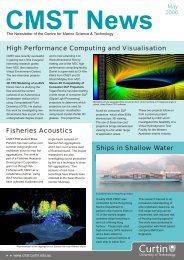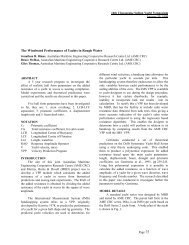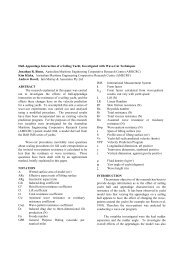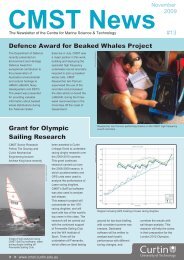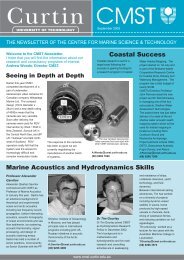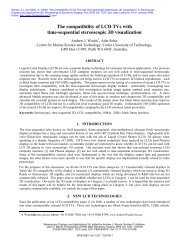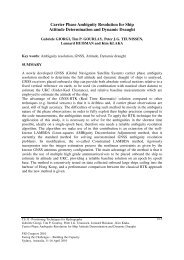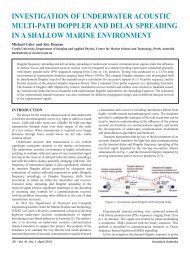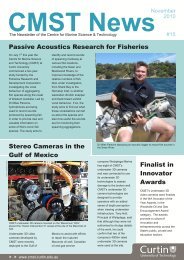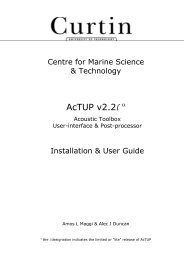Blue whale calling in the Rottnest trench-2000, Western ... - ANP
Blue whale calling in the Rottnest trench-2000, Western ... - ANP
Blue whale calling in the Rottnest trench-2000, Western ... - ANP
You also want an ePaper? Increase the reach of your titles
YUMPU automatically turns print PDFs into web optimized ePapers that Google loves.
Figure 17: Bathymetry profiles for eight tracks shown on Figure 16.<br />
As can be seen from Figure 16 and Figure 17 some of <strong>the</strong> paths cross <strong>the</strong> <strong>trench</strong> where water<br />
depths up to 1000 m are found.<br />
Two propagation codes were readily available for modell<strong>in</strong>g <strong>the</strong> transmission of signals across<br />
<strong>the</strong> <strong>trench</strong>. These were Kraken (Porter, 1994), a normal mode code, and RAM (Coll<strong>in</strong>s, 1993), a<br />
parabolic equation code. These were run <strong>in</strong> <strong>the</strong> PC environment on a 500 MHz Pentium mach<strong>in</strong>e.<br />
Each program was trialed with test, water and sediment parameters and found to give correct<br />
results. The Kraken program is a "range <strong>in</strong>dependent" program, that is it can only be set up for a<br />
s<strong>in</strong>gle environment type of constant depth. Although <strong>the</strong> water column and seabed properties<br />
could be expected to be reasonably constant throughout <strong>the</strong> study region (with water column<br />
parameters primarily chang<strong>in</strong>g with depth) <strong>the</strong> bathymetry was not. Thus <strong>the</strong> RAM program was<br />
chosen s<strong>in</strong>ce it is "range dependant" or can deal with chang<strong>in</strong>g bathymetry, water column sound<br />
speed profiles, or sediment characteristics. As a check <strong>the</strong> accuracy of <strong>the</strong> RAM and Kraken<br />
programs were compared aga<strong>in</strong>st each o<strong>the</strong>r. A constant environment problem was set up us<strong>in</strong>g<br />
<strong>the</strong> seafloor parameters listed <strong>in</strong> Table 2, <strong>the</strong> water column sound speed profile shown <strong>in</strong> Figure<br />
5 (or a 200 m deep Leeuw<strong>in</strong> current), a constant water depth of 450 m, a source at 40 m depth, a<br />
receiver on <strong>the</strong> seabed at 450 m depth and a frequency of 24 Hz. The outputs of <strong>the</strong> two<br />
programs over 5-10 km can be seen on Figure 18, along with an idealised case for ducted sound<br />
or cyl<strong>in</strong>drical spread<strong>in</strong>g (10log10[range]).<br />
The RAM and Kraken transmission loss curves shown on Figure 18 show identical trends, with<br />
<strong>the</strong> small scale differences due to <strong>the</strong> different resolutions used <strong>in</strong> <strong>the</strong> calculations. Range steps<br />
of 100 m were used <strong>in</strong> RAM and 250 m <strong>in</strong> <strong>the</strong> Kraken runs.<br />
To visualise <strong>the</strong> 2D transmission loss field <strong>the</strong> Kraken output for <strong>the</strong> above run is presented on<br />
Figure 19. It can be seen from this plot that regions of high and low transmission loss occur<br />
scattered throughout <strong>the</strong> water column, and that as predicted by <strong>the</strong> ray plot of Figure 15, <strong>the</strong> loss<br />
<strong>in</strong>creases with<strong>in</strong> <strong>the</strong> water column below <strong>the</strong> Leeuw<strong>in</strong> current base (200 m <strong>in</strong> <strong>the</strong> example)<br />
beyond approximately 10 km. The 'patch<strong>in</strong>ess' of <strong>the</strong> loss shown on Figure 19 is due to <strong>the</strong><br />
20



